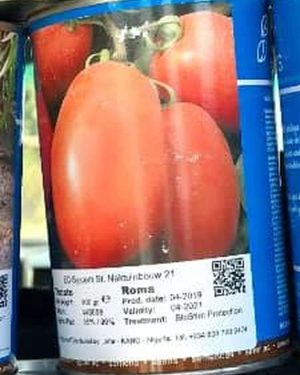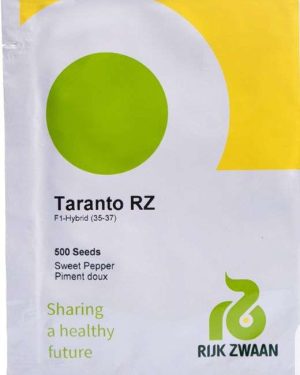Carrot Touchon Seeds (Jubaili) | 100g
₦4,755.00
The Carrot Touchon Seeds (Jubaili) | 100g is a premium Nantes-type variety known for producing uniform, cylindrical, and deep orange roots with a smooth texture and excellent flavor. Touchon is widely appreciated by farmers for its sweet taste, crisp texture, and high market value.
It performs excellently in both open-field and greenhouse conditions, making it a reliable choice for year-round production. Its roots are non-fibrous and rich in beta-carotene perfect for fresh consumption, juicing, and industrial processing.
Description
Carrot Touchon Seeds (Jubaili) | 100g is a premier, award-winning Nantes variety, revered by gardeners for its exceptional sweetness and perfect, coreless texture. As a true heirloom-type carrot, it is the gold standard for flavor, often winning blind taste tests. The 100g pack is a significant quantity, ideal for succession planting to ensure a continuous harvest of these delicious, cylindrical roots throughout the season. It’s a perfect choice for home gardeners, market growers, and anyone who believes a carrot should be a sweet, crunchy treat.
Features & Characteristics of Carrot Touchon Seeds (Jubaili) | 100g:
- Type & Shape: A classic Nantes type carrot. It has perfectly cylindrical, blunt-ended roots (not tapered) that grow 6-7 inches long, making them ideal for heavy or shallow soils.
- Color & Interior: Beautiful, smooth, bright orange skin with a deep orange interior. It is famously coreless, meaning the entire carrot is crisp, sweet, and tender with no woody central core.
- Flavor Profile: Exceptionally sweet, juicy, and crisp. Its low fiber content and high sugar levels make it arguably one of the best-tasting carrots available, perfect for eating fresh.
- Maturity: A main-season carrot, typically ready for harvest in 65-75 days from sowing.
- Bolting Tolerance: Shows good resistance to bolting (premature flowering), ensuring the plant’s energy goes into root development.
How to Plant & Germination Process:
Carrots are always grown by direct seeding, as they do not transplant well due to their taproot.
1. Site Preparation & Sowing
-
Timing: Sow seeds outdoors 2-4 weeks before the last spring frost date. Carrots can tolerate light frost. For a continuous harvest, sow successive plantings every 2-3 weeks until early summer. For a fall harvest, sow about 10-12 weeks before the first fall frost.
-
Soil Preparation: This is the most critical step for success.
-
Carrots require loose, well-draining, stone-free soil to grow straight and long.
-
Dig down to a depth of at least 12 inches, breaking up any clumps and removing rocks and debris.
-
Work in compost or sand if your soil is heavy clay. Avoid fresh manure, as it causes forking and hairy roots.
-
-
Sowing Technique:
-
Plant seeds ¼ to ½ inch (0.6 – 1.25 cm) deep.
-
Sow in rows spaced 12-16 inches apart.
-
Because seeds are tiny, try to sow them thinly. Mixing seeds with dry sand can help achieve a more even distribution.
-
2. Germination & Seedling Care
-
Germination Conditions:
-
Temperature: Germinates best in soil temperatures between 55°F – 75°F (13°C – 24°C).
-
Moisture: The soil must be kept consistently moist during the long germination period. A light layer of burlap or vermiculite over the row can help retain surface moisture.
-
Time: Carrot seeds germinate slowly, typically in 14-21 days. Patience is required.
-
-
Thinning: This is essential for proper root development.
-
First Thin: When seedlings are about 2 inches tall, thin them to 1 inch apart.
-
Final Thin: A few weeks later, thin them again to a final spacing of 2-3 inches apart. Thinning gives each carrot the space it needs to expand. The thinnings are edible and make a delicate garnish!
-
Growing Requirements:
-
Sunlight: Full sun (at least 6-8 hours of direct sunlight per day).
-
Soil: Deep, loose, sandy loam with a pH between 6.0 and 7.0.
-
Watering: Consistent, even moisture is key. Water deeply about 1 inch per week. Fluctuations in moisture can cause the roots to split or become tough.
-
Weeding: Weed carefully when plants are young, as carrots are poor competitors. Hand-pull weeds close to the seedlings to avoid damaging the shallow roots.
Harvesting and Storage:
-
Signs of Maturity: Carrots can be harvested at any size, but they are generally ready when the shoulders (the top of the root) are about ¾ to 1 inch in diameter and have a rich orange color peeking above the soil.
-
How to Harvest: Watering the bed before harvesting makes pulling easier. Grasp the foliage near the root and wiggle it gently while pulling straight up. For stubborn carrots, use a garden fork to loosen the soil beside the row.
-
Storage:
-
Short-Term: Twist off the tops (greens) about an inch above the root, as the greens will draw moisture and nutrients from the carrot. Store in the refrigerator crisper drawer for several weeks.
-
Long-Term: Can be stored in a cool, humid place like a root cellar, packed in damp sand or sawdust. They can also be canned, frozen, or fermented.
-
Applications & Uses:
-
Fresh Eating: The premier choice for eating raw. Its incredible sweetness and crisp, juicy texture make it perfect for:
-
Crudité Platters & Snacking
-
Juicing (produces a very sweet, smooth juice)
-
Salads (shredded or cut into sticks)
-
-
Cooking: Holds its shape and sweet flavor well when:
-
Steamed or Glazed
-
Roasted (caramelizes beautifully)
-
Used in soups, stews, and stir-fries
-
-
Preserving: An excellent candidate for pickling (whole baby carrots) and fermenting into carrot sticks or relish.







Reviews
There are no reviews yet